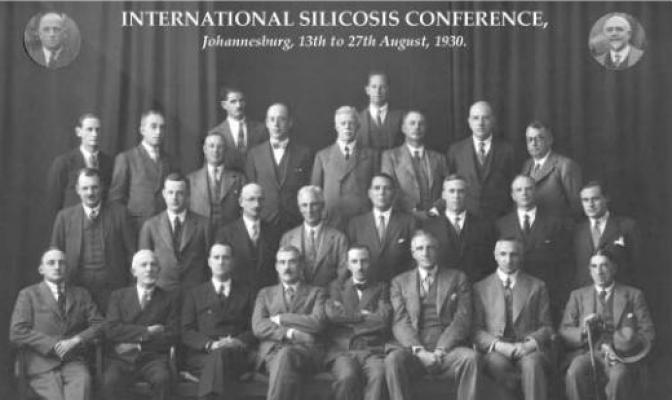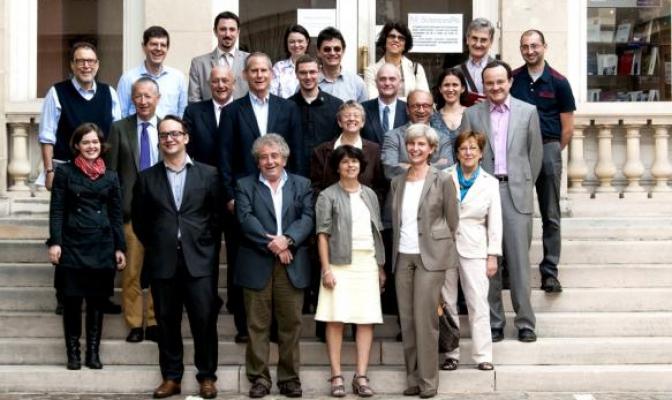Colloquium 2013

 International Silicosis Conference, Johannesburg, 13th to 27th August, 1930
International Silicosis Conference, Johannesburg, 13th to 27th August, 1930
 Revisiting the 1930 Johannesburg conference in Paris, September 2013
Revisiting the 1930 Johannesburg conference in Paris, September 2013
From silicosis to silica hazards: an experiment in medicine, history and the social sciences
Silicosis colloquium of 24-25 September 2013
Where it all began: Johannesburg 1930
The official medical definition of silicosis was established in 1930 at an international conference in Johannesburg, organised by the International Labor Office (ILO). It was attended by representatives of governments, the mining industry and medical experts (often hand-picked by industry).
Economic factors played a major role. Far from being scientifically objective, the conference produced a truncated and deliberately minimal definition of the disease, designed to reduce compensation claims and employer liability.
The forum also deliberately excluded any analysis of certain modes of exposure to risk and certain dangerous professional activities and environments, thereby neglecting a wide range of pathologies. The origin of a number of these pathologies remains disputed, but epidemiological results point to crystalline silica as a possible causal factor.
The consequences of this pivotal moment have reverberated down the decades, including a massive under-reporting of silicosis cases and frequent misdiagnosis as tuberculosis: a non-occupational disease. 83 years later, they are still hampering medical research.
Read the proceedings of the 1930 conference:
- Introduction, report of proceedings, pp. 1 to 102 (PDF, 2Mo)
- Papers presented to the conference, pp. 103 to 383 (PDF, 5.4Mo)
- Papers presented to the conference, pp. 384 to 690, Resolutions adopted by the International conference (PDF, 5.4Mo)
From Johannesburg 1930 to Paris 2013
With new developments in medical technology and growing awareness of the limitations of the official definition of silicosis, the time was ripe to revisit the 1930 Johannesburg conference and examine its political, social, medical and historical impact.
In September 2013, Sciences Po Paris hosted a major international colloquium co-organised by Paul-André Rosental, Director of SILICOSIS, and David Rosner of Columbia University’s Mailman School of Public Health. The gathering was jointly funded by the SILICOSIS project and the Alliance Program.
This unprecedented interdisciplinary experiment saw medical experts, epidemiologists, occupational health specialists and historians unite with sociologists, biologists and physicists to reflect on the 1930 conference, rethink inherited diagnostic categories and question the very foundations of current medical knowledge of silica hazards.
Participants came from as far afield as the United States, South Africa, Italy, the United Kingdom, Belgium, Canada and France. The colloquium has already given rise to a number of transdisciplinary and international collaborations and the papers presented will feature in a forthcoming publication.
See the videos
- Session 1, Silica hazards: historical and medical relevance - 24 September, 9.30am-12.30am. Speakers: David Rosner (Columbia University), Paul-André Rosental (Sciences Po & INED), Keith Breckenridge (University of Witwatersrand)
- Session 2, Observations and measures: deconstructing and reconstructing knowledge 24 September, 2-5pm. Speakers: Catherine Cavalin (Sciences Po & Centre d’études de l’emploi), Jean-François Sauvé (Université de Montréal), Jean-François Bernaudin (Université Pierre et Marie Curie-Paris 6 – Hôpital Tenon Paris)
- Session 3, Dusts and tissue : 1930-2013 and back - 25 September, 9am-1pm. Speakers: Michel Vincent (Centre hospitalier St Joseph-St Luc, Lyon & Sciences Po), Paul Blanc (University of California San Francisco), Cécile Chemarin & Mickaël Catinon (Laboratoire de minéralopathologie du Centre hospitalier St Joseph-St Luc, Lyon), Marianne Kambouchner (Centre hospitalier universitaire Avicenne, Bobigny)
- Session 4, The ghosts of silicosis past: reverberations of the 1930 conference - 25 September, 2-5.30pm,. Speakers: Francesco Carnevale (Azienda Sanitaria di Firenze & Università di Firenze), Arthur McIvor (University of Strathclyde), Eric Geerkens (University of Liège)
- Session 5: Keynote speech, Silicosis elimination: opportunities and illusions, by Gregory Wagner, Senior Advisor to the Director of the National Institute for Occupational Safety and Health (NIOSH/CDC, Wahington D.C.) & Adjunct Professor of Environmental Health at Harvard School of Public Health.












